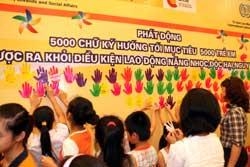At the age of 12, Lo Thi Lu, a H\'Mong girl living in the poor Lao Chaiù Commune in Sa Pa District in northern Lao Cai Province has been selling souvenirs to tourists for nearly two years.
 |
| Children paste hand-shaped stickers representing their signatures on a board to show Vietnam\'s commitment to eliminating the worst forms of child labour. – VNS Photo Truong Vi |
Like many of her friends, Lu walks 6-7 kilometres a day to sell souvenirs to support her family, as they cannot afford to make ends meet with the sole earnings from farming.
"My parents say that I have to go sell souvenirs to earn money to buy food," said Lu.
Lu is not alone when it comes to child labour. It is estimated that around 25,000 children are currently working in Vietnam, according to a meeting to commemorate the World Day Against Child Labour held Friday in Hanoi by the International Labour Organisation and the Administration for Protection and Care of Children under the Ministry of Labour, Invalids and Social Affairs (MOLISA).
Child labour was revealed to be a common practice, according to a 2009 survey conducted by MOLISA with the support of the International Labour Organisation in eight provinces and cities including Quang Nam, Lao Cai, Hanoi, An Giang and HCM City.
While children in rural areas are mainly engaged in agriculture and small-scale, household business, their counterparts in urban areas mainly work in the service sector and craft industries.
They normally work four or five hours per day, but sometimes up to six hours or longer.
Alarmingly, about 50 per cent of the working children surveyed are in bad and hazardous environments that could have serious consequences on their physical and psychological development.
Such children are also suffering from the psychological pressure of low pay, delayed payment, abuse by employers, exposure to adult behaviour and may be forced to live far from their families.
Experts said that children are most vulnerable to workplace abuses and most at risk of work-related illness or injury. This is not to mention that child labour appears to represent a significant barrier to schooling.
In the wake of this situation, the International Labour Organisation is running a four-year project, started in 2010, called Support to the Design and Implementation of National Programmes on the Elimination of Worst Forms of Child Labour.
Executors of the project are the organisation\'s International Programme on the Elimination of Child Labour, the Spanish Agency for International Development Co-operation and MOLISA.
The project works towards the prevention and eventual elimination of child labour in Viet Nam. Its pilot direct action programmes are initially expected to reach around 5,000 children involved in the worst forms of child labour in five selected provinces and cities of Ha Noi, Lao Cai, Ninh Binh, Quang Nam and Dong Nai.
Nguyen Thi Kim Ngan, Minister of Labour, Invalids and Social Affairs, said: "Elimination of child labour cannot be solved in one day; it requires not only a single policy but a comprehensive strategy. It takes the involvement of the whole community at national and international levels."
"Those who abuse and exploit child labour will be strictly punished," Ngan said.
Rie Vejs Kjeldgaard, director of the International Labour Organisation Office in Vietnam agreed with Ngan. She said that the situation had to be tackled step-by-step, with detailed plans made for each year.
According to Kjeldgaard, the issue of child labour is very much related to poverty reduction, and thus requires intervention on all levels. "No child, if they have a choice, will choose to work," she said, implying that children are forced to work because of their families\' financial difficulties.
Nguyen Thi Thu Hong, deputy chairman of the Vietnam General Federation of Labour said that the federation had organised training courses for key union officials to raise their awareness on child labour issues and children\'s rights.
Meanwhile, the Administration for Protection and Care of Children is focusing on refining the legislation regarding child labour and reinforcing the regulations on implementation, said Nguyen Hai Huu, the administration head.

Leave your comment on this story